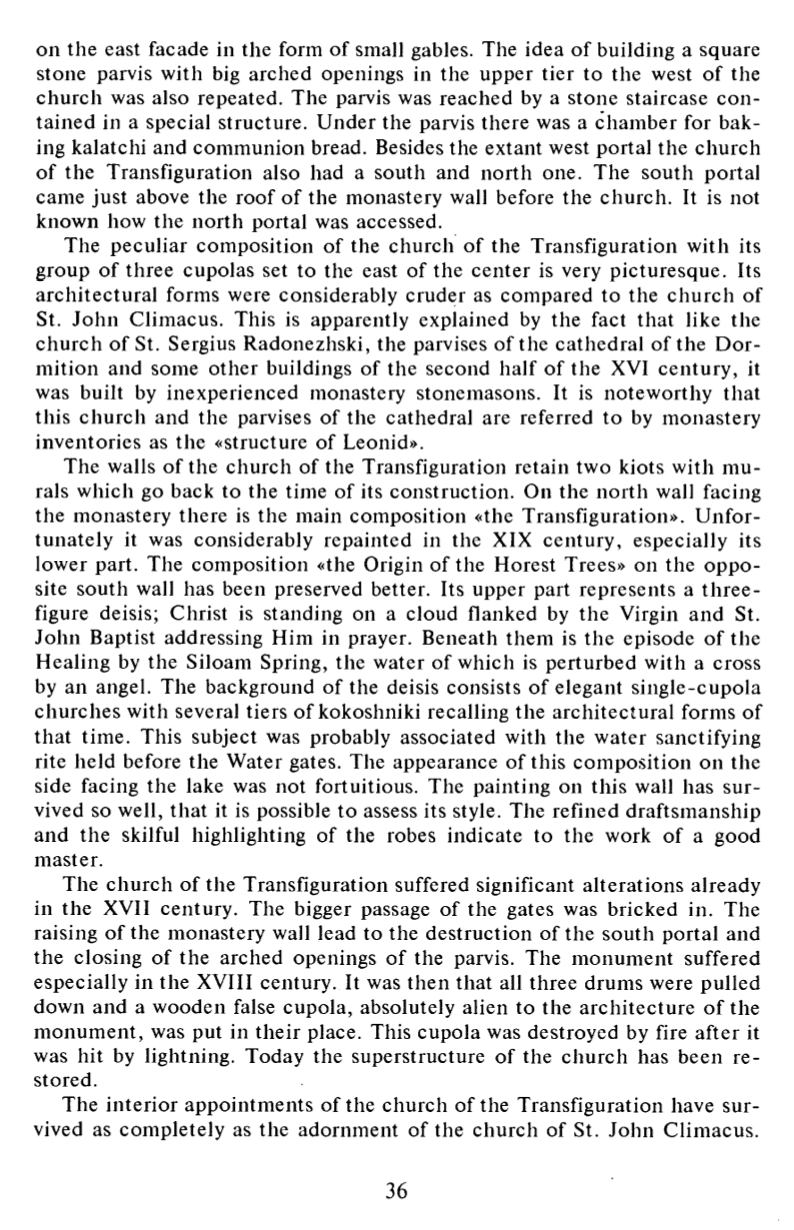

on the east facade in the form of small gables. The idea o f building a square
stone parvis with big arched openings in the upper tier to the west o f the
chu rch was also repeated. The parvis was reached by a stone staircase c o n
tained in a special structure. Unde r the parvis there was a chamber for bak
ing kalatchi and communion bread. Besides the extant west portal the church
o f the Transfiguration also had a south and north one. The south portal
came just above the roof o f the monastery wall before the church. It is not
known how the no rth portal was accessed.
The peculiar composition of the church o f the Transfiguration with its
group o f three cupolas set to the east of the center is very p icturesque. Its
a rch itectural forms were considerably cruder as compared to the chu rch of
St. John Climacus. This is apparently explained by the fact that like the
c hu rch o f St. Sergius Radonezhski, the parvises of the cathedral of the D o r
mition and some other buildings of the second half o f the XVI cen tu ry , it
was built by inexperienced monastery stonemasons. It is noteworthy that
this chu rch and the parvises of the cathedral are referred to by monastery
inventories as the «structure of Leonid».
The walls o f the church of the Transfiguration retain two kiots with m u
rals which go back to the time of its construction. On the no rth wall facing
the monastery there is the main composition «the Transfiguration». Un fo r
tunately it was considerably repainted in the XIX century, especially its
lower part. The composition «the Origin of the Horest Trees» on the oppo
site south wall has been preserved better. Its upper part represents a th ree -
figure deisis; Christ is standing on a cloud flanked by the Virgin and St.
John Baptist addressing Him in prayer. Beneath them is the episode o f the
Healing by the Siloam Spring, the water of which is perturbed with a cross
by an angel. The background of the deisis consists o f elegant single-cupola
chu rches with several tiers o f kokoshniki recalling the architectural forms of
that time. This subject was probably associated with the water sanctifying
rite held before the Water gates. The appearance of this composition on the
side facing the lake was not fortuitious. The painting on this wall has su r
vived so well, that it is possible to assess its style. The refined draftsmanship
and the skilful highlighting of the robes indicate to the work o f a good
master.
The chu rch o f the Transfiguration suffered significant alterations already
in the XVII century. The bigger passage of the gates was bricked in. The
raising o f the monastery wall lead to the destruction of the south portal and
the closing o f the arched openings o f the parvis. The monumen t suffered
especially in the XVIII century. It was then that all three drums were pulled
down and a wooden false cupola, absolutely alien to the arch itec tu re o f the
monumen t, was put in their place. This cupola was destroyed by fire after it
was hit by lightning. Today the superstructure of the chu rch has been r e
stored.
The in terior appointments of the church of the Transfiguration have su r
vived as completely as the adornment of the church of St. John Climacus.
36















